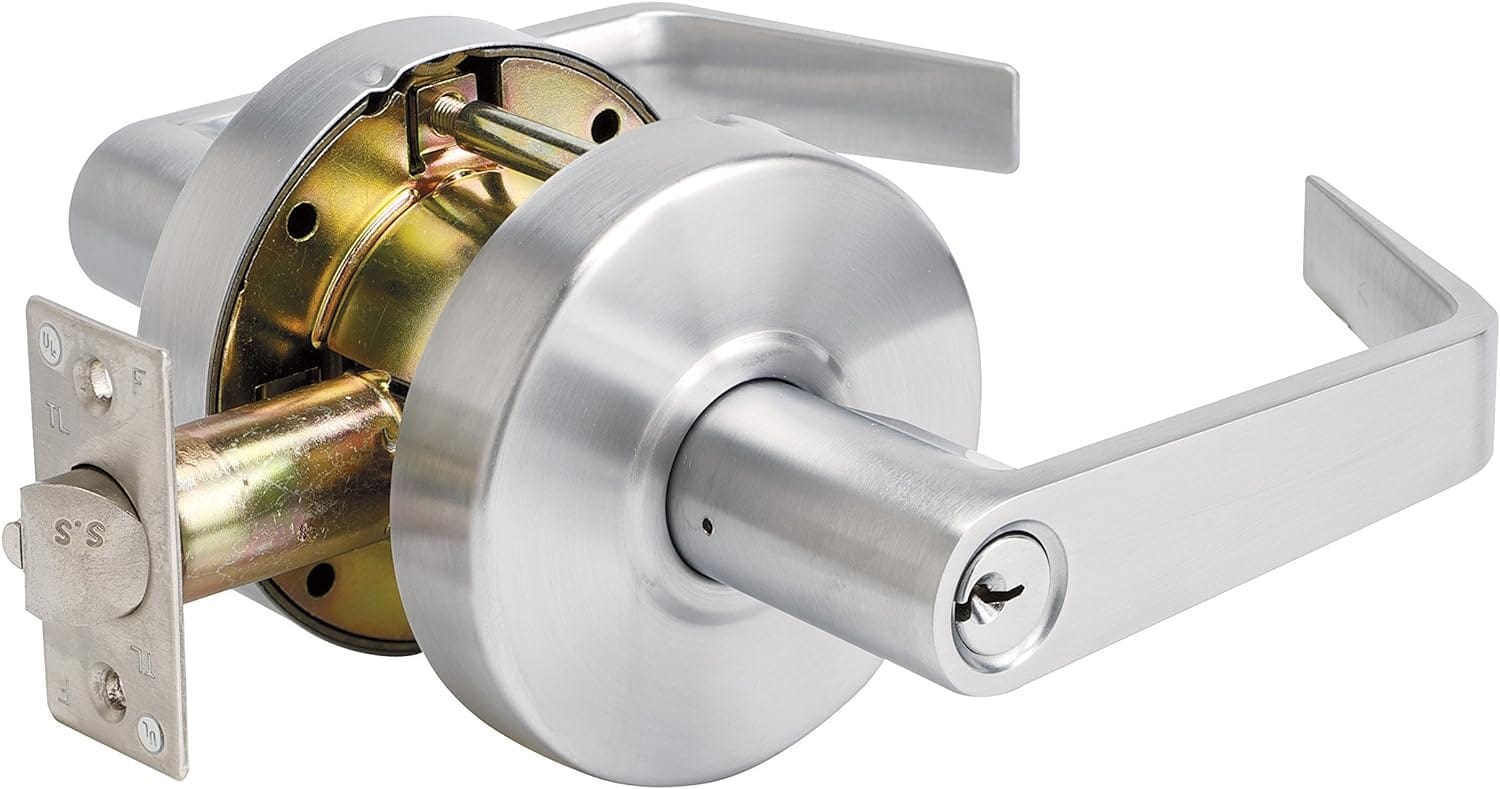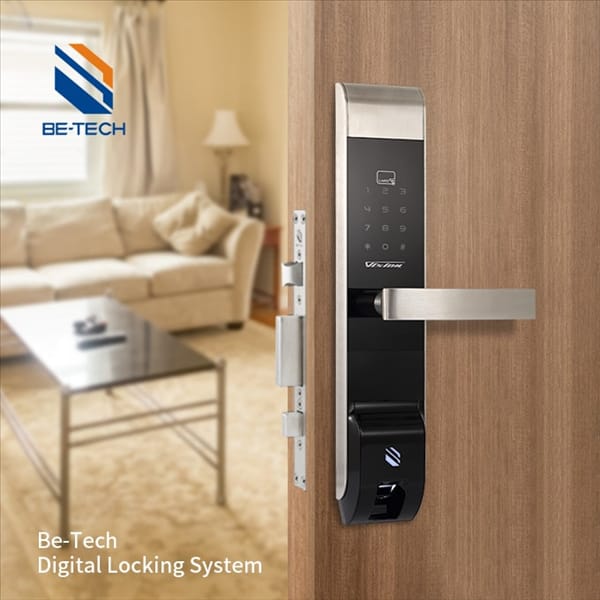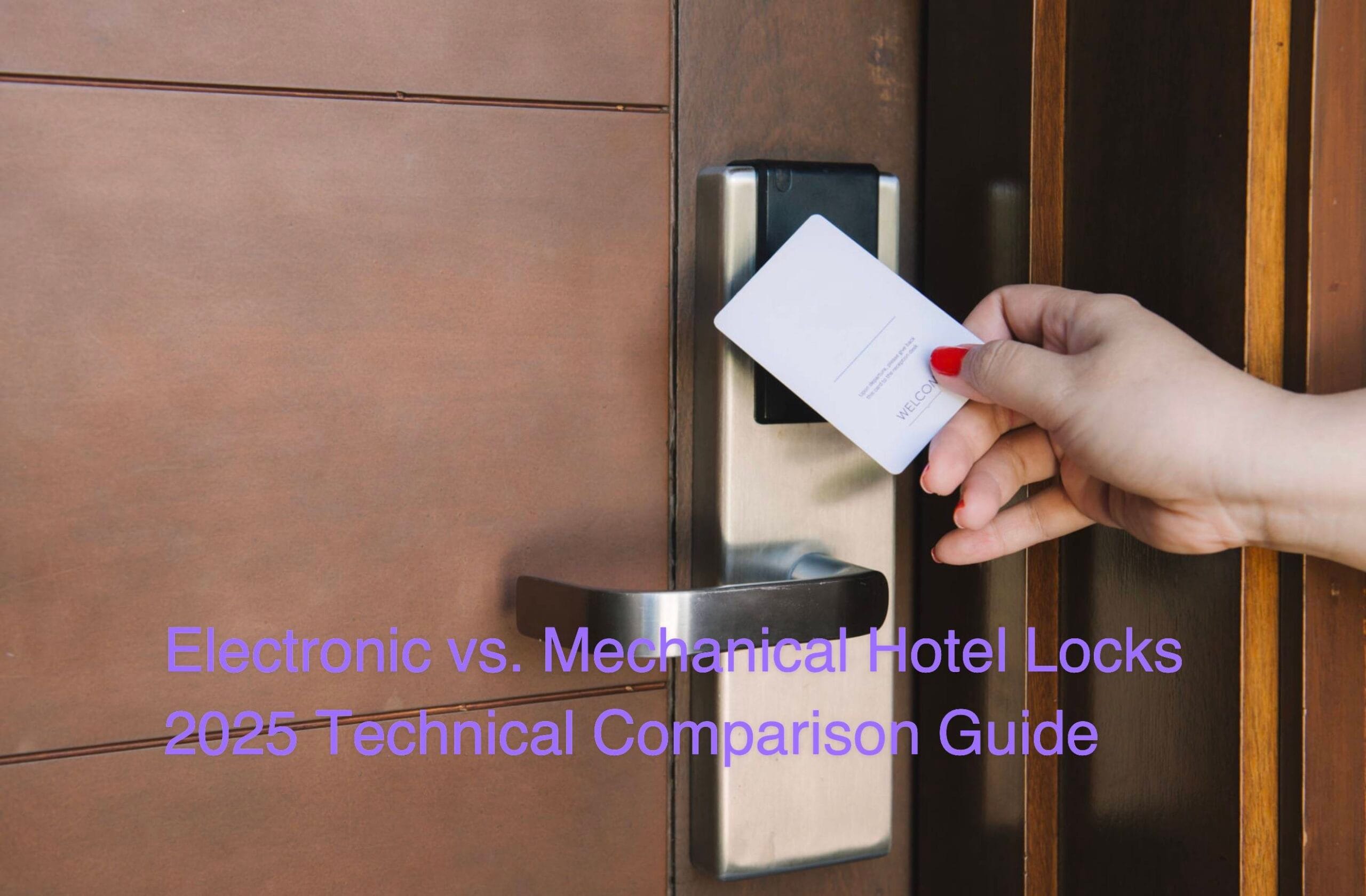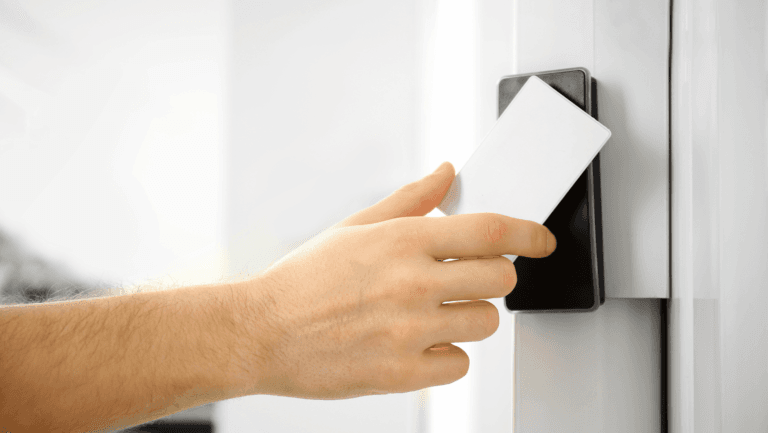In the hospitality industry, door locks represent the first line of defense for guest security while simultaneously influencing operational efficiency and guest satisfaction. As technology evolves, hotel properties face increasingly complex decisions when selecting between traditional mechanical locks and advanced electronic systems. This comprehensive comparison examines both options through a technical lens, providing hotel operators with actionable insights for 2025 and beyond.
Understanding Lock System Fundamentals
Mechanical Hotel Locks: Core Components and Operation

Mechanical hotel locks have served as the foundation of hotel security for decades. These systems operate through purely mechanical means, using physical keys and pin tumbler mechanisms to secure doors. The fundamental components include:
- Lock cylinder: Contains pins of varying lengths that align when the correct key is inserted
- Key: Features unique cuts that correspond to the pin configuration
- Latch mechanism: Secures the door to the frame when engaged
- Strike plate: Mounted on the door frame to receive and secure the latch
Traditional mechanical locks function without electricity, relying instead on the precise interaction between the key’s pattern and the corresponding pins inside the lock cylinder. When the correct key is inserted, the pins align at the “shear line,” allowing the cylinder to rotate and activate the latch mechanism.
While mechanical locks have undergone refinements over time, their core technology remains relatively unchanged. According to industry standards established by the American National Standards Institute (ANSI), mechanical locks are classified into three grades based on security and durability:
- Grade 1: Commercial-grade, highest security and durability (can withstand 360+ pound force)
- Grade 2: Heavy-duty residential, excellent security (withstands 250+ pound force)
- Grade 3: Standard residential, minimum acceptable grade
These classifications apply to both mechanical and electronic systems, providing a standardized measure of physical security regardless of technology.
Electronic Hotel Locks: Evolution and Classification

Electronic hotel locks represent a significant technological advancement, incorporating electronic components to enhance security, convenience, and management capabilities. The evolution of electronic locks has progressed through several key generations:
1. Magnetic Stripe Locks
The first wave of electronic hotel locks utilized magnetic stripe technology, where access credentials were encoded on cards with magnetic strips. These systems represented the initial departure from traditional keys but had limitations including demagnetization, wear on readers, and vulnerability to skimming.
2. RFID (Radio Frequency Identification) Locks
RFID technology marked a significant advancement, using radio waves to identify and authenticate access credentials. These contactless systems offer improved reliability and security over magnetic stripe technology. According to recent statistics, RFID systems now dominate the hospitality sector, with implementation in over 68% of hotels worldwide.
Key components of RFID lock systems include:
- RFID reader integrated into the lock
- Encoded credentials (keycards, fobs)
- Control unit with electronic memory
- Mechanical locking mechanism activated electronically
3. Smart Locks (Mobile Access, Biometric)
The latest generation of electronic locks incorporates multiple technologies, including:
- BLE (Bluetooth Low Energy): Enables smartphone-based access
- Biometric authentication: Uses fingerprints, facial recognition, or other unique biological identifiers
- Cloud connectivity: Facilitates remote management and integration with other systems
According to a 2025 hospitality technology survey, mobile access adoption has reached nearly 47% of hotels globally, with the highest penetration in luxury and upscale properties.
Technical Comparison: Security Architecture
Physical Security Mechanisms
Both mechanical and electronic locks must provide robust physical security against forced entry attempts. However, their approaches differ significantly:
Mechanical Locks
- Rely on hardened steel components and complex pin arrangements
- Security depends primarily on the quality of materials and precision of manufacturing
- Vulnerability to traditional lock-picking techniques
- Limited ability to detect tampering attempts
Electronic Locks
- Combine electronic authentication with mechanical locking components
- Employ anti-tamper features that trigger alarms or lockdowns when manipulation is detected
- Include reinforced components to resist physical attacks
- Feature encrypted communication between credentials and lock
A significant advantage of electronic systems is their ability to detect and record unauthorized access attempts. According to a 2024 security study, hotels using electronic locks with tamper alerts experienced 64% fewer successful break-in attempts compared to properties using mechanical systems.
Key Management and Access Control
The management of access credentials represents one of the most substantial differences between mechanical and electronic systems:
| Feature | Mechanical Locks | Electronic Locks |
|---|---|---|
| Credential Type | Physical keys | Keycards, mobile devices, biometrics |
| Duplication Risk | High (keys can be copied) | Low to none with encryption |
| Lost Credential Response | Replace lock cylinder or rekey | Deactivate and issue new credential |
| Access Hierarchy | Limited master key levels | Unlimited customizable access levels |
| Temporary Access | Difficult to implement | Easily programmed with expiration |
| Remote Management | Not possible | Available with networked systems |
Electronic systems offer significant advantages in access control flexibility. For example, Be-Tech’s Guardian RFID hotel lock system allows properties to create time-limited access credentials, instantly revoke compromised cards, and maintain detailed access logs—capabilities impossible with mechanical systems.
Vulnerability Assessment
Understanding security vulnerabilities is essential for comprehensive risk management:
Mechanical Lock Vulnerabilities
- Susceptible to lock-picking and bumping techniques
- Master keys present significant security risks if lost
- No inherent ability to track usage or unauthorized attempts
- Keys can be easily duplicated without detection
Electronic Lock Vulnerabilities
- Software and firmware vulnerabilities requiring updates
- Potential for electronic bypassing (though increasingly difficult with encryption)
- Battery or power failure concerns (mitigated with backup systems)
- Potential for advanced hacking attacks on networked systems
Recent research has highlighted specific vulnerabilities in some electronic systems. For example, in March 2024, security researchers identified a flaw affecting over 3 million Saflok door locks used in hotels worldwide. This underscores the importance of selecting systems with regular security updates and robust encryption.
Be-Tech addresses these concerns with advanced encryption in their RFID hotel lock systems, which feature AES-256 encryption standards and regular security updates to protect against emerging threats.
Operational Efficiency Analysis
Installation and Implementation Requirements
The installation process for hotel door locks varies significantly between mechanical and electronic systems:
Mechanical Lock Installation
- Generally simpler installation process
- Requires minimal wiring or infrastructure
- Typically involves mounting the lockset, strike plate, and aligning components
- Installation can often be completed with basic tools and skills
Electronic Lock Installation
- More complex installation requirements
- May involve wiring for hardwired systems
- Requires programming and system setup
- Often needs specialized technicians for proper implementation
For properties considering a transition from mechanical to electronic systems, Be-Tech offers retrofit options that can minimize disruption and reduce installation costs compared to full replacement.
Maintenance Requirements and Longevity
Maintenance needs differ substantially between lock types, affecting long-term operational costs:
Mechanical Lock Maintenance
- Periodic lubrication of moving parts
- Occasional realignment of strike plates
- Physical wear on keys requiring replacement
- Complete rekeying when security is compromised
Electronic Lock Maintenance
- Battery replacement (for battery-powered models)
- Software and firmware updates
- Reader cleaning and calibration
- Electronic component diagnostics and replacement
According to industry data, mechanical locks typically require physical maintenance every 3-6 months, while modern electronic systems can operate with minimal intervention for 12-18 months between maintenance cycles.
Integration With Hotel Management Systems
Modern hotel operations increasingly rely on integrated technology ecosystems:
Mechanical Locks
- Function independently from other hotel systems
- Manual key tracking and management
- No automated connection to check-in/check-out processes
- Require physical interaction for all functions
Electronic Locks
- Integrate with Property Management Systems (PMS)
- Automatic credential generation upon check-in
- Synchronization with guest management databases
- Ability to interface with energy management, billing, and other smart room features
The integration capabilities of electronic systems deliver significant operational efficiencies. Hotels implementing fully integrated electronic access control systems report front desk labor savings of 15-20% and improved guest satisfaction scores by eliminating key-related issues during check-in.
Cost-Benefit Analysis: Investment Considerations
Initial Investment Comparison
The upfront cost difference between mechanical and electronic systems is significant:
Mechanical Lock Costs
- Lower hardware costs ($80-150 per door for basic systems)
- Minimal infrastructure requirements
- Lower installation costs
- Key management systems and key stock
Electronic Lock Costs
- Higher hardware costs ($250-800+ per door depending on features)
- Potential infrastructure upgrades (network, servers)
- Higher installation complexity and cost
- Management software and credential issuance equipment
While the initial investment for electronic systems is higher, this gap has narrowed in recent years. According to 2025 market data, the cost of basic RFID hotel lock systems has decreased by approximately 23% since 2020, making electronic options more accessible to mid-tier and economy properties.
Total Cost of Ownership (TCO) Assessment
A comprehensive cost evaluation must consider long-term ownership expenses:
| Cost Factor | Mechanical Locks | Electronic Locks |
|---|---|---|
| Initial Hardware | Lower | Higher |
| Installation | Lower | Higher |
| Maintenance Labor | Higher (frequent) | Lower (infrequent) |
| Rekeying/Security Breach | Very high | Minimal |
| Lost Key Management | Ongoing expense | Minimal |
| Energy Costs | None | Low (batteries/power) |
| Staff Efficiency | Lower | Higher |
| Integration Benefits | None | Substantial |
| Upgrade Pathway | Limited | Extensive |
When analyzed over a typical 7-10 year lifecycle, electronic systems often demonstrate a more favorable TCO despite higher initial costs. According to a 2025 hospitality industry study, hotels that switched from mechanical to electronic locks saw an average ROI within 2.5 years, primarily through reduced labor costs and decreased security incidents.
For a detailed ROI analysis specific to your property type and size, Be-Tech offers an ROI calculator that accounts for these variables.
Guest Experience Impact
Check-in and Access Experience
The guest journey is significantly influenced by lock technology:
Mechanical Locks
- Traditional key handover at front desk
- Physical key management throughout stay
- Risk of lockouts if key is lost
- Familiar operation for all demographics
Electronic Locks
- Options for mobile check-in and keyless entry
- Reduced front desk queuing time
- Multiple access options (card, mobile, etc.)
- Enhanced perception of property technology level
According to a 2025 guest preference survey, 72% of business travelers and 58% of leisure travelers prefer hotels offering mobile key options, indicating a clear shift in consumer expectations.
Accessibility and Universal Design
Modern hospitality must address accessibility needs:
Mechanical Locks
- Limited adaptability for guests with physical limitations
- Often require fine motor control to operate
- Few customization options for special needs
Electronic Locks
- Contactless options for easier access
- Programmable features for accessibility needs
- ADA-compliant designs more readily available
- Mobile access accommodates various physical abilities
The Americans with Disabilities Act (ADA) mandates specific requirements for lodging facilities, including regulations for door hardware. Electronic locks often provide better compliance with these standards, particularly systems offering multiple access methods.
Security Standards and Regulatory Compliance
Industry Certifications and Standards
Hotel lock systems must meet established industry standards:
Key Industry Standards
- ANSI/BHMA A156 standards for locks and hardware
- UL 1034 for burglary-resistant electronic locks
- UL 294 for access control systems
- ISO 27001 for information security (electronic systems)
Compliance Considerations
- Fire safety regulations requiring specific egress functions
- ADA requirements for operating force and design
- Local building codes and hospitality regulations
- Data protection standards for electronic systems
The Be-Tech Guide to Hotel Lock Standards provides detailed information about compliance requirements for various property types and locations.
Data Security and Privacy
Electronic systems introduce data security considerations:
Critical Data Security Factors
- Encryption standards for access credentials
- Guest data handling and storage
- Network security for connected systems
- Vulnerability management and update protocols
Electronic lock manufacturers have responded to these concerns with enhanced security measures. Leading systems now implement AES-256 bit encryption, secure boot verification, and penetration testing to protect against cyber threats.
Future Trends and Innovation (2025)
Emerging Technologies Shaping Hotel Security
The hotel lock landscape continues to evolve with new technologies:
Biometric Integration
Biometric authentication is experiencing rapid adoption, with fingerprint and facial recognition becoming mainstream options. By 2025, approximately 28% of luxury hotels have implemented some form of biometric access control, balancing security with guest privacy concerns.
Mobile-First Access Strategies
Mobile access has moved beyond novelty to becoming an expected amenity. Advanced systems now offer:
- Seamless app integration with hotel services
- Location-based access to amenities
- Personalized room settings triggered by access
- Contactless journey throughout the property
IoT and Smart Room Connectivity
Modern electronic locks serve as gateways to connected room experiences:
- Integration with lighting and climate controls
- Voice-activated room features
- Occupancy-based energy management
- Personalized guest preferences stored in access credentials
Hotels implementing these integrated systems report energy savings of 20-30% while enhancing guest satisfaction scores.
Decision Framework for Lock System Selection
Property Assessment Factors
To determine the optimal lock system, hotels should evaluate:
Property Characteristics
- Size and layout of the property
- Number of access points requiring control
- Existing infrastructure capabilities
- Brand standards and design requirements
Operational Considerations
- Staffing model and front desk operations
- Technical support capabilities
- Budget constraints (capital vs. operational)
- Integration requirements with existing systems
Guest Demographics
- Primary guest segments (business, leisure, groups)
- Guest technology preferences and expectations
- Security concerns specific to location
- Accessibility requirements
Implementation Strategy
For properties transitioning between systems, a structured approach is essential:
Phased Implementation Options
- Floor-by-floor rollout to manage costs and disruption
- Public areas first, followed by guest rooms
- New construction vs. renovation considerations
- Hybrid approaches during transition periods
Staff Training Requirements
- Front desk credential management procedures
- Maintenance team troubleshooting capabilities
- Security protocols and emergency access procedures
- Guest education and support
The Be-Tech guide to hotel door lock systems provides additional implementation insights tailored to different property types.
Conclusion: Making the Optimal Choice
The decision between mechanical and electronic hotel locks involves balancing security, operational efficiency, guest experience, and financial considerations. While mechanical locks continue to serve basic security needs with lower initial costs, electronic systems deliver significant advantages in security, management flexibility, and guest satisfaction.
In 2025’s competitive hospitality landscape, electronic locks—particularly those offering mobile access and integration capabilities—have become the standard for properties focused on enhancing guest experiences while optimizing operations. The ongoing reduction in technology costs has made these systems increasingly accessible to properties across all segments.
When evaluating options, hotels should:
- Assess their specific property needs and guest expectations
- Calculate total cost of ownership beyond initial investment
- Consider future expansion and integration requirements
- Evaluate security vulnerabilities specific to their location
- Balance staff capabilities with system complexity
By thoroughly evaluating these factors against the comprehensive comparison provided in this guide, hotel operators can make informed decisions that enhance security, improve operational efficiency, and elevate the guest experience for years to come.
For additional guidance on selecting the optimal hotel lock system for your specific property needs, visit Be-Tech’s comprehensive resource center for customized consultation and solutions.




